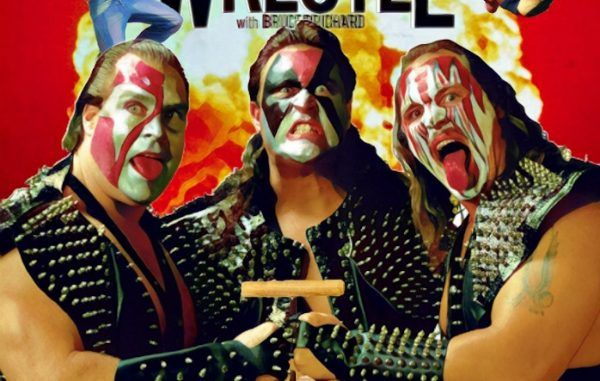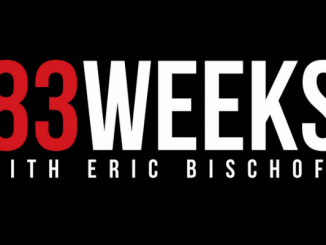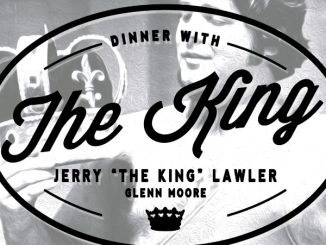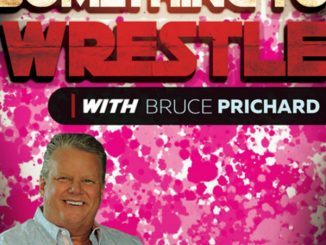
Something To Wrestle With Bruce Prichard – Demolition
Air date: July 14, 2017
Recap by: Jeff Rush, PWPodcasts.com Specialist
DIRECT LINK TO LISTEN/DOWNLOAD
Noteworthy items: Though Bruce has a bit of a reputation as being a WWF-lifer and apologist, over the course of this show, he proclaimed to be a bigger fan of both Demolition members earlier persona’s prior to joining the company. He liked Ax, but he loved the Masked Superstar. He thought Smash was great, but was a huge fan of Krusher Kruschev.
What happened when Demolition joined the WWF?
Ax and Smash debuted before Bruce joined the WWF. Though Barry Darsow would eventually achieve fame as a member of Demolition, he first portrayed an evil Russian named Krusher Kruschev in the NWA.
Randy Colley, who portrayed Moondog Rex in the 1980’s, first proposed the idea of Demolition, with himself teaming with Bill Eadie. Eadie would go on to portray Ax, but Colley would be ruled out as his partner.
Conrad asks Bruce to describe the Demolition gimmick. Bruce says the idea was that they were two big tough, rugged guys who demolished their opponents. They talk about how the team kind of had an S&M-type look. Bruce says, sure, it had kind of a dominatrix thing going on, but that they were also going for a Jason from Friday the 13th look.
Apparently too many people recognized Colley from his Moondog days and weren’t buying him as Smash in Demolition. Crowds would chant “Moondog, Moondog” at Colley and Vince decided not to use him in the role. It’s crazy because I remember Moondog Rex as looking like your average middle aged dude with a beard. Pictures online back this up. I find it incredibly astute of the live crowds in 1987 (and super “smart” of WWF fans of the era) to recognize Colley and call him out at live shows about it. I think Colley should hang his hat on having gotten so much out of the odd, non-descript Moondog gimmick that people wouldn’t let him escape it.
The guys discuss Bill Eadie’s early days. He most famously wrestled as the Masked Superstar in Georgia and Florida and also as the Super Machine as part of an entertaining angle revolving around the feud between Andre the Giant and Bobby Heenan in the mid-’80s. In a fun spot here, Conrad asks Bruce who Eadie’s most iconic character is, assuming he’ll say Ax. Conrad says older fans are marks for the Masked Superstar so they say that, but what does Bruce think? Turns out Bruce is one of those older fans. He loved the Masked Superstar gimmick. He says for this generation, it’ll be Demolition, but that he’ll always be Masked Superstar to him.
Barry Darsow is a Minnesota guy. He grew up as friends with the Road Warriors (interesting considering the comparisons Demolition would get to them over the years), Wayne Bloom, Tom Zenk and a host of others. Darsow was a bouncer at a club familiar to wrestling fans called Grandma B’s. He was recruited by Eddie Sharkey and trained to wrestle.
Demolition debuted on Wrestling Challenge versus Don Driggers and S.D. Jones. Bruce loved Jones, says he was a great hand but was just missing “it.”
Bruce also takes a moment here to work in a staple of the show – trash talking Terry Taylor. He says Taylor was booking Florida “for about three weeks.” When Bill Eadie had his final match there, as Masked Superstar. After losing a match that stipulated he would be unmasked, Eadie was chased to the back, never getting unmasked in front of the live crowd. Instead, Ted Dibiase “caught him” backstage and returned with his mask. The problem was Eadie had wrestled in a black mask, and Dibiase returned with a red one. Bruce says this is the kind of stuff that kills territories and probably a reason why Terry didn’t have much luck in booking.
Conrad then asks Bruce for his thoughts on the “Road Warrior rip off” claim often leveled at Demolition. He says he’d always heard Vince was interested in the Road Warriors. He vaguely recalls a meeting after arriving in the WWF with the Road Warriors. He says shortly after that meeting, Vince called and told him they were going full steam ahead with Demolition and Powers of Pain.
Bruce feels Demolition were different from the Road Warriors. He says WWF fans accepted them as two different teams, even though NWA fans cried “rip-off” more. He says there were more comparisons to Powers Of Pain and the Road Warriors than with Demolition, as both teams were largely based on physique.
(I gotta say, I grew up in Eastern Pennsylvania (pretty solid WWF territory back then) and was 10 years old when Demolition debuted. My older brother and I ALWAYS saw Demolition as Road Warrior rip-offs. It didn’t stop us from getting our parents to buy PPVs and wrestling figures. It didn’t stop me from enjoying Demolition as the WWF’s version of the Road Warriors. It got me super excited about their eventual matchup against the Warriors a couple years later. I think you can feel all those things and still recognize that, without the Road Warriors, there would never be a Demolition. Anyway, back to the show.)
The guys continue to discuss how the facepaint and spikes also drew comparisons between the two. Bruce maintains that Demolition were better performers.
Demolition were initially managed by Lucious Johnny V. Bill Eadie requested they switch to Mr. Fuji. Bruce talks about how Johnny Valiant attended Military School together with Vince McMahon. He feels Johnny V was set for as long as he was in the WWF because of this. He says he was, however, too flamboyant for a badass team like Demolition. Bruce says, looking back, it’s hard to imagine Demolition with any other manager than Mr. Fuji.
Bruce then discusses Fuji’s reputation as a great ribber.
Conrad runs down the winning streak that Demolitions carried throughout 1987 and ignited their career. They largely worked the syndicated shows – Superstars and Wrestling Challenge – going over teams like the Young Stallions and the Islanders. Bruce talks about how this was the textbook method of creating a heel back in the day. We got a limited glimpse of this with Braun Strowman most recently, and it’s hard to argue with it’s success.
By late 1987, Bruce is plugged into the backstage happenings. The inaugural Survivor Series took place that year and was the first PPV in the WWF for both Bruce and Demolition.
Bruce says the tag team elimination match at Survivor Series was a mess. There were too many wrestlers (20!) surrounding the ring and it was nearly impossible to get a clear shot of any in-ring action. Eventually they made use of a crane to catch the action.
Demolition was left off the first Royal Rumble that January. Bruce says it was only a two hour show and they simply didn’t have room for everyone. Conrad notes that the Islanders and Young Stallions closed out that show with a lengthy 2-out-of-3 falls match. Why go with that match instead of giving time to your hottest, undefeated, tag act? Bruce jokes that he didn’t want to get beat up by Haku.
Demolition was again left off of The Main Event that February. Bruce says he believes Vince was waiting for WrestleMania IV to give them their launch.
Next, the guys discuss Demolition’s iconic entrance song. It was created and performed by Rick Derringer, the guy who had a ’70s hit with “Rock and Roll Hoochie Koo.” I’m referring not only to the original, but the Mean Gene duet that appeared on the first Piledriver album.
This leads to a discussion about Jimmy Hart and his song writing abilities. Bruce considers him a “musical genius savant.” He recalls Jimmy and Jim Johnston bringing a keyboard into meetings regarding theme songs, describing a wrestlers background to them and the Jim just rattling off a song. Conrad says if Hart had made a bigger stink about owning rights to the songs he wrote, he’d be a much wealthier man today. Bruce counters that had he put up much of a stink, Vince probably would’ve just used someone else.
Demolition was beginning to receive babyface reactions by the time WrestleMania IV rolled around in March of 1988. Bruce says, unfortunately, the audience doesn’t always react the way you image them reacting. He says the crowd was beginning to love the cool, tough guy image portrayed by Ax and Smash.
Demolition went over Strike Force at WMIV to win their first WWF Tag Championships. Bruce discusses the cane shot that Ax hit Rick Martel with to end that match. He says 30 years later, he still recalls how well it was sold by Martel. He feels wrestlers today could learn from watching that finish.
Following WrestleMania, Demolition would continue to win squash matches on the syndicated shows.
At the inaugural SummerSlam in 1988, Demolition successfully defended their titles over the Hart Foundation. Jimmy Hart was at odds with his former team and Demolition won the match with the use of his megaphone. Bruce jokes that this, coupled with the finish of their WMIV match, was becoming the formula for their victories.
Bruce tells a story about being guest referee Brother Love for a match between the newly turned babyface Hart Foundation and the heel Rougeau Brothers at Boston Gardens. He says prior to the match, he was going over his involvement with Bret. The plan was for him to be a heel ref and to screw the Hart Foundation wherever he could. This included the plan for Bruce to cut off Bret’s comeback.
“My first babyface comeback in ten years and you’re gonna f**king cut me off? Yeah, that’s not gonna happen.”
Needless to say, Bret got his way.
Demolition again took part in the 20-man tag match at the 1988 Survivor Series. Bruce notes that they learned from the previous year and got much better shots of the action. This is the match where Fuji seemingly accidentally causes Demolition to get eliminated, only to later fully turn on them. He would then align with the Powers Of Pain, completing a double turn. Bruce says Demolition were already getting babyface reactions everywhere and that no one was buying Powers Of Pain as faces, that they were more seen as Road Warrior rip offs. He feels the fans wanted Demolition to be their team.
Next, we discuss the 1989 Royal Rumble. Demolition had a memorable moment here, with Ax entering at no. 1 and Smash at no. 2. Bruce says this was done to get over the unpredictability of the Rumble match. This was only the second Rumble and, thusly, the first time they really had the opportunity to drive home the concept of “anything can happen.”
Bruce talks a bit more about the Powers Of Pain never really clicking as a team. They squared off against Demolition at WrestleMania V with Fuji as their partner, making it a handicap match. Bruce says they added Fuji to the match because he was the whole story.
The Brain Busters, Arn Anderson and Tully Blanchard debuted in fall of 1988. Bruce says JJ Dillon brokered the deal that brought them in from the NWA. He says pairing them with Bobby Heenan was a hell of a package and that everyone loved to work with them.
The Brain Busters would defeat Demolition for the tag titles at Saturday Night’s Main Event in July 1989. This would conclude their run with the titles at 478 days. Bruce says this was done to elevate the Brain Busters stock and to move in a different direction with the tag scene. The match itself was a lengthy 2-out-of-3 falls match, which Bruce says was done to showcase the enormous talent of the four wrestlers.
SummerSlam 1989 saw Demolition team with “King” Hacksaw Jim Duggan, facing Andre the Giant, Akeem, and Big Bossman. Bruce says they wanted to feature Duggan and Andre but without giving them a one-on-one match. Smash would bodyslam both Akeem and Bossman in this match. Conrad asks if there was ever a plan to have him slam Andre as well. Bruce says it was never even a talking point, that Vince wanted to leave that as a special accomplishment by Hulk Hogan.
In November of 1989, Demolition defeated the Brain Busters at a TV taping to win the tag titles for the second time. Conrad asks why they didn’t hold off until Survivor Series for the switch. Bruce says they were looking to pop a TV rating for sweeps and that you can’t otherwise apply logic to it. I would add that, at this time, Survivor Series was strictly a card of multi-person tag matches, that titles had never been put on the line on that show to this point.
The guys spend a minute here discussing Tully Blanchard’s backstage reputation. Apparently, he wasn’t the most likable guy in the back. Even Arn could take him or leave him half the time.
Andre and Haku were put together in a team called the Colossal Connection. They would defeat Demolition for the tag titles in December 1989. Bruce says this was seen as Andre’s last hoorah. Haku was paired with him as the guy to do all the wrestling in their matches, with Andre seen as the attraction.
The two teams worked the house show circuit for a few months leading up to WrestleMania VI. There, Demolition would regain the titles. Following the match, Andre would beat Heenan up, thusly turning babyface. This would be his last televised match with the WWF. Conrad notes that Andre was good friends with Bill Eadie dating back to the Machine days of 1986 and even prior. Andre also trusted Barry Darsow and Haku and was close to Heenan, so it was a way to give him a nice send off.
By this point, Bruce says Demolition was seen as “the” team in the WWF.
Following WrestleMania VI, Demolition traveled to Japan to work at the All Japan Summit. Eadie had done a lot as Super Destroyer in Japan and was well known there.
During this trip, Eadie fell ill. It was supposedly the result of a shellfish allergy. Bruce says it affected his heart and even led to a procedure where they had to shock him, stopping his heart for a moment. Eadie was hospitalized for 4-5 days. Bruce says his wrestling career was never the same after this.
Upon their return home, Vince approached Eadie about being a road agent for the company with a possible on-air role as Demolition’s manager, with the team bringing on a new member.
That third member would be Brian Adams, who would assume the moniker Crush. Adams had been working in Oregon as the American Ninja and was introduced to the WWF through Roddy Piper.
Bruce felt Adams was practically interchangeable with Darsow and was, thus, an excellent fit to the group.
The team turned heel here with the idea being they could employ the “Freebird rule”, allowing any two of the three to defend their titles on any given night. It’s noted that this was almost always Smash and Crush, as Ax was pretty much done at this point.
Bruce takes a moment here to explain the Michael Hayes “doot doot doot” impression he does. He reveals that Hayes himself never says this, that it’s just the sound he imagines when he sees Hayes walking. I’ll be damned.
Smash and Crush would lose the titles for the final time to the Hart Foundation at SummerSlam 1990. It was in yet another 2-out-of-3 falls match. They tried out a switcheroo with Ax interfering and hiding under the ring. The Legion Of Doom, having recently debuted in the company, would come to the ring and beat Demolition up and costing them the titles.
Bruce says this was around the time they began considering singles runs for Smash and Crush. He says a feud against the Legion Of Doom, while viewed as a dream match, never had a chance because there was such a clash of styles between the two teams.
All three members of Demolition would go on to have a series of matches verses the LOD and the Ultimate Warrior. Bruce says it was an attraction but that it pretty much sucked. I saw this match main event a TV taping at Hershey Arena and, I must say, it was the highlight of my summer that year.
By Survivor Series 1990, Demolition was being pushed to use masks instead of face paint. This, among other changes, was beginning to wear on Bill Eadie. Bruce says it was simply done to allow them to switch places during a match without the ref noticing.
Eadie felt he still had some wrestling days, was unhappy to be used in a part time role and left the company following Survivor Series.
He would go on to use the name Axis the Demolisher on the indie circuit. This led to legal issues with the WWF and the guys then discuss Vince’s penchant for going after certain guys, but not others in this regard and how it was almost done on a whim.
Demolition’s final match was in a losing effort in September 1991 in Japan. The guys agree that this was an anti-climactic end to an iconic team.
Crush would take a leave of absence shortly thereafter. Bruce believes this had to do with his getting stopped at the Canadian border and caught with steroids.
Smash would run as a singles performer for a bit before undergoing a major gimmick overhaul and becoming the Repo Man. Bruce points out that he was not with the company during this time, but that this was one of the worst gimmicks ever, even more so than the Goon and Bastion Booger.
Darsow would perform as Repo Man throughout 1992, with his last WWF PPV being the 1993 Royal Rumble. It should be noted that he also had a multi-show program with Randy Savage during the earliest episodes of Monday Night Raw. Bruce was back with the company at this time and I would’ve loved an anecdote or two about this program, as it was undoubtedly the highest-profile moment of the Repo Man character, but alas, it wasn’t meant to be.
Conrad asks Bruce for his opinion on Demolition’s legacy. Where does he rank them on the list of WWF tag teams. Bruce says number one. He feels they were the ultimate team in the company throughout their run. He feels they will one day be in the Hall of Fame.
The show closes out with a few Twitter questions and Bruce performing the opening of Demolition’s theme as Jim Cornette.
Thoughts: In the days following this episode, it became clear not everyone was a huge fan. Even Johnny Fairplay tweeted his, I guess, indifference toward the show. Conrad himself has said he wasn’t the biggest fan of the episode, even though he did profess to be a Demolition fan several times during the show. I gotta say, I kinda loved it. It was a break from the norm in that we didn’t get many impressions, other than Bruce doing his best yelling Smash during one of the ad breaks. There wasn’t a lot of “noteworthy” information revealed, and I agree with one Twitter user’s assertion that Conrad sounded more like a lawyer reading a deposition throughout than his usual engaged, fired up self. Numerous times, he felt like he was trying to get blood out of a turnip, but the story was something Bruce just didn’t recall a lot about.
What I loved about this episode was Bruce’s recollections sounded so natural. Without the numerous impressions and trademark bickering between Conrad and Bruce, we really got back to the feeling this show had before it’s popularity skyrocketed. It sounded like someone who had done a done of research on a given subject sat down with someone who knew a lot about it and we got to listen in. Making it even better was that it was about an era not often discussed on the show – the earliest of Bruce’s years in the WWF. I love getting a show from the ’80s as much as I do from the end of his run in 2008, and we’ve now gotten both in a span of three weeks. I feel, generally speaking, most people have been too hard on this episode.
If you’re a fan of 1980’s WWF or maybe just want to understand it a little better, give this show a go. 8/10
Time Stamps
10:35: Show begins
11:30: The Moondogs
12:57: The Demolition concept
14:25: S&M Outfits
16:30: Bringing in Barry Darsow
20:09: Bill Eadie
21:51: Darsow background
24:45: SD Jones
27:10: Not LOD ripoffs
30:30: Powers Of Pain
34:31: Luscious Johnny V
36:00: Mr. Fugi
43:30: Survivor Series 87
52:55: Entrance song/Jimmy Hart
58:10: Getting cheers
59:22: WrestleMania IV
1:03:08: WrestleFest 88
1:06:05: SummerSlam 88
1:08:15: Going over Hart Foundation
1:12:48: Survivor Series 88
1:16:15: Double turn with Powers Of Pain
1:24:52: Royal Rumble 89, Nos. 1 & 2
1:27:28: WrestleMania V
1:30:20: The Brain Busters
1:33:50: No Holds Barred
1:34:30: 478 days as tag champs
1:39:40: SummerSlam 89
1:42:15: Winning the tag titles again
1:44:30: Tully Blanchard
1:45:04: Survivor Series 89
1:46:44: The Colossal Connection
1:49:50: WrestleMania VI
1:51:00: Andre The Giant
1:53:13: All Japan
1:58:28: Crush
2:01:10: Road Warriors join WWE
2:03:48: SummerSlam 90
2:09:30: Three man tag matches
2:13:00: Possible jump to WCW
2:15:30: Survivor Series 90
2:19:20: Royal Rumble 91
2:15:55: WrestleMania VII
2:23:15: Repo Man
2:25:00: Lawsuit over the Demolition name
2:28:35: Twitter questions




Be the first to comment